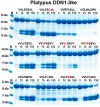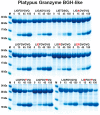Extended cleavage specificities of two mast cell chymase-related proteases and one granzyme B-like protease from the platypus, a monotreme
- PMID: 31906570
- PMCID: PMC6981407
- DOI: 10.3390/ijms21010319
Extended cleavage specificities of two mast cell chymase-related proteases and one granzyme B-like protease from the platypus, a monotreme
Abstract
Mast cells (MCs) are inflammatory cells primarily found in tissues in close contact with the external environment, such as the skin and the intestinal mucosa. They store large amounts of active components in cytoplasmic granules, ready for rapid release. The major protein content of these granules is proteases, which can account for up to 35 % of the total cellular protein. Depending on their primary cleavage specificity, they can generally be subdivided into chymases and tryptases. Here we present the extended cleavage specificities of two such proteases from the platypus. Both of them show an extended chymotrypsin-like specificity almost identical to other mammalian MC chymases. This suggests that MC chymotryptic enzymes have been conserved, both in structure and extended cleavage specificity, for more than 200 million years, indicating major functions in MC-dependent physiological processes. We have also studied a third closely related protease, originating from the same chymase locus whose cleavage specificity is closely related to the apoptosis-inducing protease from cytotoxic T cells, granzyme B. The presence of both a chymase and granzyme B in all studied mammals indicates that these two proteases bordering the locus are the founding members of this locus.
Keywords: animal model; chymase; cleavage specificity; human chymase; mast cell; monotremes; platypus.
Conflict of interest statement
The authors declare no conflict of interest.
Figures






Similar articles
-
The Evolutionary History of the Chymase Locus -a Locus Encoding Several of the Major Hematopoietic Serine Proteases.Int J Mol Sci. 2021 Oct 11;22(20):10975. doi: 10.3390/ijms222010975. Int J Mol Sci. 2021. PMID: 34681635 Free PMC article. Review.
-
Extended Cleavage Specificities of Rabbit and Guinea Pig Mast Cell Chymases: Two Highly Specific Leu-Ases.Int J Mol Sci. 2019 Dec 16;20(24):6340. doi: 10.3390/ijms20246340. Int J Mol Sci. 2019. PMID: 31888202 Free PMC article.
-
Extended cleavage specificity of the mast cell chymase from the crab-eating macaque (Macaca fascicularis): an interesting animal model for the analysis of the function of the human mast cell chymase.Int Immunol. 2012 Dec;24(12):771-82. doi: 10.1093/intimm/dxs081. Epub 2012 Sep 4. Int Immunol. 2012. PMID: 22949566
-
Extended substrate specificity of opossum chymase--implications for the origin of mast cell chymases.Mol Immunol. 2008 Apr;45(7):2116-25. doi: 10.1016/j.molimm.2007.10.015. Epub 2007 Nov 19. Mol Immunol. 2008. PMID: 18022236
-
Mast Cell and Basophil Granule Proteases - In Vivo Targets and Function.Front Immunol. 2022 Jul 5;13:918305. doi: 10.3389/fimmu.2022.918305. eCollection 2022. Front Immunol. 2022. PMID: 35865537 Free PMC article. Review.
Cited by
-
Mast Cells and Basophils in the Defense against Ectoparasites: Efficient Degradation of Parasite Anticoagulants by the Connective Tissue Mast Cell Chymases.Int J Mol Sci. 2021 Nov 23;22(23):12627. doi: 10.3390/ijms222312627. Int J Mol Sci. 2021. PMID: 34884431 Free PMC article.
-
Extended Cleavage Specificity of two Hematopoietic Serine Proteases from a Ray-Finned Fish, the Spotted Gar (Lepisosteus oculatus).Int J Mol Sci. 2024 Jan 30;25(3):1669. doi: 10.3390/ijms25031669. Int J Mol Sci. 2024. PMID: 38338947 Free PMC article.
-
The Evolutionary History of the Chymase Locus -a Locus Encoding Several of the Major Hematopoietic Serine Proteases.Int J Mol Sci. 2021 Oct 11;22(20):10975. doi: 10.3390/ijms222010975. Int J Mol Sci. 2021. PMID: 34681635 Free PMC article. Review.
-
Extended cleavage specificities of human granzymes A and K, two closely related enzymes with conserved but still poorly defined functions in T and NK cell-mediated immunity.Front Immunol. 2023 Jul 11;14:1211295. doi: 10.3389/fimmu.2023.1211295. eCollection 2023. Front Immunol. 2023. PMID: 37497217 Free PMC article.
-
Extended Cleavage Specificity of the Rat Vascular Chymase, a Potential Blood Pressure Regulating Enzyme Expressed by Rat Vascular Smooth Muscle Cells.Int J Mol Sci. 2020 Nov 12;21(22):8546. doi: 10.3390/ijms21228546. Int J Mol Sci. 2020. PMID: 33198413 Free PMC article.
References
MeSH terms
Substances
Grants and funding
LinkOut - more resources
Full Text Sources

